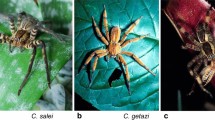Abstract
Drosophila melanogaster is able to detect a small visual object hidden in a background of identical texture, as long as there is relative motion between their retinal images. The properties of figure-ground discrimination in the walking fly are studied under experimental conditions where the positions of figure and ground oscillate sinusoidally with similar frequency and similar amplitude but with different phase. The following points have been established. (a) The average turning reaction of the stationarily walkingDrosophila depends on phase; contrary to results obtained with the flyingMusca (Reichardt and Poggio, 1979), antiphasic oscillation of figure and ground does not suppress the attrativeness of the figure. (b) A translatory response has been found which also depends on the phase difference of the oscillatory movements of figure and ground. (c) The time course of the responses and its intra- and inter-individual variability do not seem to fit into a rigid model of figure-ground discrimination.
Similar content being viewed by others
References
Buchner, F.: Elementary movement detectors in an insect visual system. Biol. Cybern.24, 85–101 (1976)
Bülthoff, H.: Orientation behaviour ofDrosophila melanogaster. Dissertation, Eberhard-Karls-Universität Tübingen, 1980
Bülthoff, H., Poggio, T., Reichardt, W.: Figure-ground discrimination by relative movement in the visual system of the fly. Part II. Movement and relative movement algorithms. To be submitted to Biol. Cybern. (1981)
Götz, K.G.: Optomotorische Untersuchungen des visuellen Systems ciniger Augenmutanten der FruchtfliegeDrosophila. Kybernetik2, 77–92 (1964)
Poggio, T., Reichardt, W.: Visual control of orientation behaviour in the fly. Part II. Towards the underlying neural interactions. Q. Rev. Biophys.9, 377–438 (1976)
Poggio, T., Reichardt, W.: On the representation of multi-input systems: Computational properties of polynomial algorithms. Biol. Cybern.37, 167–186 (1980)
Reichardt, W., Poggio, T.: Visual control of orientation behaviour in the fly. Part I. A quantitative analysis. Q. Rev. Biophys.9, 311–375 (1976)
Reichardt, W., Poggio, T.: Figure-ground discrimination by relative movement in the visual system of the fly. Part I. Experimental results. Biol. Cybern.35, 81–100 (1979)
Reichardt, W., Poggio, T.: Visual control of flight in flies. In: Theoretical developments of neurobiology. Neuroscience research programm bulletin. Cambridge, MA, London: MIT Press 1980
Reichardt, W., Poggio, T., Hausen, K.: A neuronal circuitry for figure-ground discrimination by the visual system of the fly. Naturwissenschaften (1981) (in press)
Virsik, R., Reichardt, W.: Tracking of moving objects by the flyMusca domestica. Naturwissenschaften61, 132–133 (1974)
Virsik, R., Reichardt, W.: Detection and tracking of moving objects by the flyMusca domestica. Biol. Cybern.23, 83–98 (1976)
Author information
Authors and Affiliations
Rights and permissions
About this article
Cite this article
Bülthoff, H. Figure-ground discrimination in the visual system ofDrosophila melanogaster . Biol. Cybern. 41, 139–145 (1981). https://doi.org/10.1007/BF00335368
Received:
Issue Date:
DOI: https://doi.org/10.1007/BF00335368




